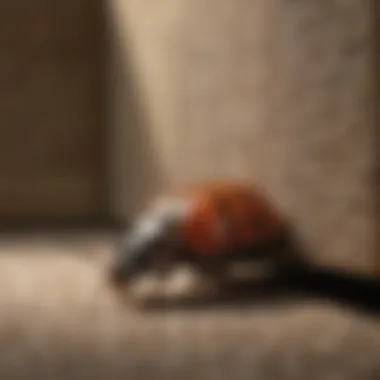Comprehensive Guide to Effective Carpet Beetle Eradication at Home


Preventive Pest Control Strategies
When it comes to protecting your home from unwanted intruders like carpet beetles, implementing preventive pest control strategies is paramount. One key aspect is safeguarding the exterior of your house - ensure to seal up any cracks or gaps that could serve as entry points for pests. Regularly clearing debris also helps in reducing potential hiding spots for these pests. By taking proactive measures to prevent pests from entering your home, you can establish a strong line of defense against carpet beetle infestations.
In addition to focusing on the exterior, yard maintenance plays a vital role in pest control. Engaging in essential yard care routines such as mowing the lawn regularly and keeping vegetation trimmed can discourage pests from taking shelter in your yard. Implementing methods to keep your yard pest-free, such as eliminating standing water that attracts insects, further contributes to a pest-resistant outdoor environment.
Maintaining cleanliness indoors is another fundamental element of pest control. Employ expert cleaning tips and techniques to ensure that your indoor spaces are inhospitable to carpet beetles. Regularly vacuuming carpets, dusting furniture, and decluttering areas where pests could hide prove effective in keeping these unwanted guests at bay.
Efficient garbage disposal also plays a critical role in pest prevention. Properly disposing of waste not only keeps your home clean and odor-free but also removes potential food sources that could attract carpet beetles. Emphasizing the importance of correct garbage disposal practices to all household members is key in maintaining a pest-free environment.
To complement these strategies, exploring innovative ways to safeguard your home against a variety of pests can provide added protection. From using natural repellents to adopting environmentally-friendly pest prevention techniques, diversifying your pest control approach can strengthen your defenses against carpet beetles and other nuisance pests.
Understanding Carpet Beetles
Carpet beetles are insidious pests that can wreak havoc on your home if left unchecked. Understanding these creatures is crucial to effectively combatting their infestations. By identifying the physical characteristics and behaviors of carpet beetles, you can strategically implement eradication tactics to safeguard your living environment.
Identification of Carpet Beetles
Carpet beetles are small, oval-shaped insects known for their diverse physical characteristics. These pests range in color from black to mottled patterns of white, brown, and yellow. Their size typically varies between 1 to 4 millimeters long, making them easily overlooked. This inconspicuous appearance aids carpet beetles in infiltrating homes undetected, where they feed on a variety of organic materials. Understanding the physical traits of carpet beetles is paramount in differentiating them from other household pests and initiating targeted elimination methods.
Physical Characteristics of Carpet Beetles
The physical characteristics of carpet beetles play a significant role in their lifecycle and habits. Their small size and intricate patterns serve as camouflage, allowing them to blend seamlessly into fabrics and carpets. Additionally, the hard exoskeleton of carpet beetles provides protection against predators and environmental hazards. While their size may be advantageous for hiding in narrow spaces, it also makes them challenging to detect during initial infestations. By recognizing and scrutinizing these distinct physical attributes, homeowners can promptly address carpet beetle issues before substantial damage occurs.
Behavior and Habitat of Carpet Beetles
Carpet beetles exhibit scavenging behaviors, feeding on natural fibers, fur, feathers, and even stored food products. Their destructive feeding habits pose a threat to household items like carpets, clothing, upholstered furniture, and bedding. Understanding carpet beetles' affinity for dark, secluded areas in homes is essential for implementing control measures effectively. By comprehending their preference for warm, undisturbed environments, homeowners can focus eradication efforts on key infestation sites.
Damage Caused by Carpet Beetles
The damage inflicted by carpet beetles extends beyond mere inconvenience, encompassing significant consequences for property and inhabitants. Recognizing the types of damage caused by these pests illuminates the urgency of addressing infestations promptly.
Types of Damage from Carpet Beetles
Carpet beetles inflict damage through two primary mechanisms: larval feeding and textile destruction. Larvae actively consume organic materials, such as wool, silk, and leather, leading to visible holes and irregular patterns in fabrics. Furthermore, the excretion of larvae can stain fabrics permanently, exacerbating the aesthetic deterioration caused by feeding. Understanding these distinct forms of damage facilitates the identification and mitigation of carpet beetle presence, safeguarding belongings from irreparable harm.


Impact on Property
The impact of carpet beetles on property transcends material damage, extending to financial implications and emotional distress for homeowners. Prolonged infestations can result in extensive structural harm to carpets, furniture, and other vulnerable items. Moreover, the constant threat of reinfestation perpetuates anxiety and discomfort among residents. Acknowledging the pervasive impact of carpet beetles underscores the necessity of proactive eradication measures to preserve property value and peace of mind.
Lifecycle of Carpet Beetles
Understanding the lifecycle stages of carpet beetles is fundamental to disrupting their reproduction and population growth within homes. By dissecting each developmental phase, homeowners can tailor eradication strategies to combat these pests effectively.
Egg Stage
The egg stage marks the initiation of a carpet beetle's lifecycle, wherein adult females deposit eggs in suitable environments rich in food sources. These tiny, oval-shaped eggs possess a sticky texture, adhering to fibers and fabrics to ensure the larvae's sustenance upon hatching. Awareness of the potential egg-laying sites enables proactive measures to intercept and eliminate these reproductive sources before larvae emerge.
Larval Stage
During the larval stage, carpet beetles exhibit voracious feeding behaviors to support their growth and development. The larvae are particularly destructive, relying on keratin consumption from animal-based materials to thrive. Their mobility and insatiable appetite make them highly detrimental to textile possessions, necessitating vigilant monitoring and intervention to prevent widespread damage.
Pupal Stage
As larvae reach maturity, they enter the pupal stage, where they undergo significant physiological changes in preparation for adulthood. Pupae are enclosed within protective silken cocoons, hidden in secluded locations within homes. This dormant phase signifies a crucial juncture for control efforts, as disrupting pupae development hampers the emergence of new carpet beetle generations.
Adult Stage
The adult stage heralds the culmination of a carpet beetle's growth cycle, during which they emerge from pupae as winged insects. Adults seek out mates to initiate the reproductive cycle, perpetuating infestation cycles within households. Their ability to fly enables widespread dissemination, posing challenges in containment and extermination. By understanding the distinct characteristics and behaviors of adult carpet beetles, homeowners can devise comprehensive eradication strategies to interrupt the breeding cycle and prevent reinfestation.
Preventive Measures
Preventive measures play a vital role in the comprehensive eradication of carpet beetles from your home. By proactively implementing preventive strategies, you can safeguard your living space from these pesky pests. One of the key elements of preventive measures is maintaining overall cleanliness, which includes regular vacuuming and proper storage of clothing and fabrics. Ensuring a clean environment not only eliminates existing threats but also deters future infestations, promoting a pest-free living space.
Maintaining Cleanliness
Maintaining cleanliness is essential in the battle against carpet beetles. Regular vacuuming is a cornerstone of this strategy, effectively removing eggs, larvae, and adult beetles from carpets and furniture. The meticulous removal of dirt, dust, and debris also eliminates food sources for carpet beetles, inhibiting their growth and reproduction. Regular vacuuming not only prevents infestations but also improves indoor air quality, creating a healthier living environment. Despite its effectiveness, regular vacuuming may require time and effort, emphasizing the need for consistency in this maintenance task.
Storage of Clothing and Fabrics
Proper storage of clothing and fabrics is another crucial aspect of maintaining cleanliness and preventing carpet beetle infestations. Storing items in sealed containers or garment bags prevents beetles from accessing and damaging natural fibers such as wool and silk. Additionally, keeping closets organized and decluttered reduces hiding spots for beetles and larvae. While the use of mothballs was once a common practice, opting for natural repellents like cedar blocks is a safer and more environmentally friendly alternative. However, cedar blocks require periodic replacement to maintain their potency, adding a maintenance aspect to this preventive measure.
Sealing Entry Points


Sealing entry points in your home is a fundamental step in preventing carpet beetles from infiltrating your living space. By checking windows and doors for gaps and ensuring proper seals, you limit potential entryways for beetles. Repairing cracks and gaps in walls, floors, and foundations further fortifies your home against pest intrusion. While this process may require initial investment and time, the long-term benefits of sealing entry points outweigh the associated costs. Consistent monitoring and maintenance of these sealed areas are necessary to address any new vulnerabilities and uphold the integrity of your home's defenses.
Proper Storage Methods
Utilizing proper storage methods is key to safeguarding your clothing and fabrics from carpet beetle damage. Storing items in air-tight containers prevents pests from accessing and infesting your belongings. The use of storage solutions like vacuum-sealed bags adds an extra layer of protection against beetles and other fabric-damaging critters. Moreover, incorporating cedar blocks for natural repellent provides a chemical-free alternative to safeguarding stored items. However, it's essential to periodically check and replace these cedar blocks to maintain their effectiveness. Implementing these proper storage methods not only protects your belongings but also contributes to a pest-free home environment.
Natural Remedies
Essential Oils
Essential oils are potent extracts derived from plants with various therapeutic properties. In the context of carpet beetle eradication, two essential oils stand out for their insect-repelling qualities: Lavender Oil and Peppermint Oil.
Lavender Oil
Lavender Oil is renowned for its calming fragrance, but it also serves as a powerful insect deterrent. Its distinctive floral scent masks the pheromones that attract carpet beetles, effectively repelling them from your home. Furthermore, Lavender Oil is safe to use around pets and children, adding to its appeal as a natural remedy for pest control.
Peppermint Oil
Peppermint Oil offers a refreshing aroma that carpet beetles find intolerable. Its strong menthol scent disrupts the insects' sensory receptors, deterring them from infesting your carpets and fabrics. Additionally, Peppermint Oil has antimicrobial properties, further enhancing its usefulness in combatting carpet beetles.
Diatomaceous Earth
Diatomaceous Earth is a natural sedimentary rock powder composed of fossilized remains of diatoms. It acts as a mechanical insecticide, effectively absorbing the waxy outer layer of carpet beetles, leading to dehydration and death.
Application Methods
When using Diatomaceous Earth, ensure thorough coverage of infested areas such as carpets, rugs, and furniture. Apply a thin layer of the powder and leave it for a few days to allow it to desiccate the beetles. Vacuum the treated areas afterward to remove the dead insects and repeat the process if necessary.
Effectiveness
One of the key benefits of Diatomaceous Earth is its long-lasting effect. Unlike chemical insecticides that lose potency over time, Diatomaceous Earth remains active as long as it is dry. This makes it a sustainable solution for carpet beetle eradication without the need for frequent reapplication.
Chemical Treatments
Chemical treatments play a crucial role in the comprehensive guide to eradicating carpet beetles. When it comes to dealing with these resilient pests, chemical treatments offer a potent solution that is essential in effectively eliminating them from your living space. One of the key benefits of chemical treatments is their ability to target carpet beetles at different stages of their life cycle, including larvae and adults. This ensures a thorough eradication process, preventing re-infestation. Moreover, chemical treatments effectively penetrate carpets, furniture, and other infested areas, reaching deep into crevices where beetles may hide. While chemical treatments are potent, considerations such as ensuring proper ventilation during application and following safety guidelines are crucial to protect both residents and pets from exposure.
Insecticides


Types of Insecticides
Types of insecticides play a pivotal role in the eradication process by offering specific benefits tailored to combat carpet beetles. One key characteristic of insecticides is their ability to disrupt the growth and development of carpet beetle larvae, thus halting their life cycle effectively. This feature makes insecticides a popular choice for swiftly addressing infestations and preventing further damage to fabrics and furniture. Moreover, the unique feature of residual action in certain insecticides ensures prolonged protection against future infestations, providing long-term relief for homeowners. While insecticides are effective, proper application and adherence to safety guidelines are essential to maximize their benefits and minimize any potential risks or adverse effects.
Application Guidelines
Application guidelines are essential in optimizing the effectiveness of insecticides in eradicating carpet beetles. Proper application techniques, such as evenly distributing the product in infested areas and focusing on target sites where beetles are likely to dwell, are critical for achieving comprehensive coverage. One key characteristic of application guidelines is the recommended frequency of treatments based on the severity of infestation, ensuring a systematic approach to eradication. Adhering to application guidelines not only enhances the efficacy of insecticides but also minimizes the chances of resistance development among carpet beetles. While following application guidelines is beneficial, consulting with professionals for complex infestations is recommended to ensure proper execution and maximize results.
Professional Extermination
When to Consider
Knowing when to consider professional extermination is paramount in dealing with persistent carpet beetle infestations. One key characteristic of considering professional extermination is its practicality for extensive or recurring infestations that may require specialized treatment methods. Professional extermination becomes a beneficial choice when DIY approaches have proven ineffective or when infestations pose risks to property or health. The unique feature of professional expertise in identifying hidden infestation sources and implementing targeted solutions sets it apart as a comprehensive option for homeowners seeking long-term relief from carpet beetles. While professional extermination offers undeniable advantages, assessing the cost-effectiveness and reputation of pest control services is crucial to making an informed decision that aligns with your eradication goals.
Choosing a Pest Control Service
Selecting the right pest control service is a critical step in ensuring effective carpet beetle eradication. One key characteristic of choosing a pest control service is evaluating their experience and expertise in handling carpet beetle infestations specifically. Opting for a reputable service provider with a track record of successful extermination projects instills confidence in the quality of service you can expect. The unique feature of tailored treatment plans offered by professional pest control services ensures customized solutions based on the unique requirements of your home and the extent of infestation. While choosing a pest control service offers undeniable advantages, considering factors such as service guarantees, pricing transparency, and eco-friendly practices can further enhance the overall experience and outcomes of the eradication process.
Monitoring and Maintenance
In this section, we delve into the crucial aspect of monitoring and maintaining a pest-free environment, specifically focusing on carpet beetle eradication. Effective monitoring and maintenance play a pivotal role in preventing reinfestation and ensuring the long-term success of eradication efforts. By regularly inspecting key areas for signs of infestation and monitoring the progress of treatment methods, homeowners can proactively address any potential resurgence of carpet beetles before it escalates into a full-blown problem. This proactive approach not only saves time and effort but also eliminates the need for extensive remediation measures.
Regular Inspections
Signs of Infestation:
One of the key aspects of regular inspections is identifying signs of carpet beetle infestation. These signs can include damaged fabric or carpets, shedding of beetle skins, and presence of fecal pellets. The ability to recognize these indicators early on is crucial for swift and effective intervention. Regular inspections allow homeowners to pinpoint the source of infestation and take immediate action to eradicate the pests. By being vigilant and responsive to these signs, individuals can safeguard their homes from extensive damage and protect their belongings.
Monitoring Progress:
Monitoring progress involves tracking the effectiveness of chosen eradication methods and evaluating the impact on the infestation. This step allows homeowners to adjust their approach accordingly based on the observed outcomes. By monitoring progress regularly, individuals can determine the success of treatment measures, identify any areas requiring additional attention, and fine-tune their eradication strategies for optimal results. This iterative process of monitoring progress enables homeowners to stay one step ahead of the carpet beetles and ensures that efforts are consistently aligned with the goal of complete eradication.
Preventive Practices
Incorporating preventive practices is essential for maintaining a pest-free environment and minimizing the risk of future infestations. Sustainable habits, such as proper storage of clothing and fabrics, meticulous cleanliness, and regular household maintenance, form the foundation of effective pest control. By adhering to sustainable habits, homeowners can create an inhospitable environment for carpet beetles, thereby reducing the likelihood of infestation recurrence. These practices not only deter pests but also promote overall well-being and cleanliness within the home.
Sustainable Habits:
Sustainable habits encompass eco-friendly and pest-preventive actions that contribute to a healthy living space. Examples include using natural repellents, adopting green cleaning practices, and minimizing clutter to eliminate potential hiding spots for carpet beetles. By embracing sustainable habits, homeowners can achieve long-term pest control benefits while reducing their ecological footprint. These practices align with a holistic approach to pest management, emphasizing the importance of environmental sustainability alongside pest eradication.
Long-Term Strategies:
Long-term strategies involve implementing measures that provide sustained protection against carpet beetles over an extended period. This may include periodic deep cleaning, strategic placement of deterrents, and ongoing vigilance in detecting early signs of infestation. By combining sustainable habits with long-term strategies, homeowners can fortify their defenses against carpet beetles and safeguard their homes for the future. These comprehensive approaches not only address current infestations but also lay the groundwork for preventing potential pest problems, ensuring a pest-free living environment in the long run.



